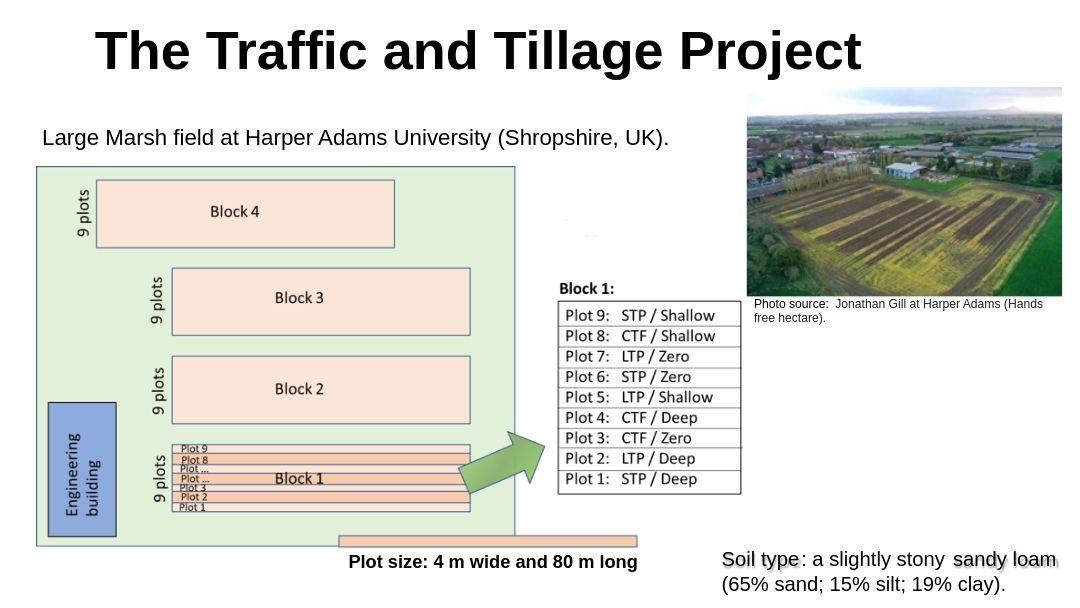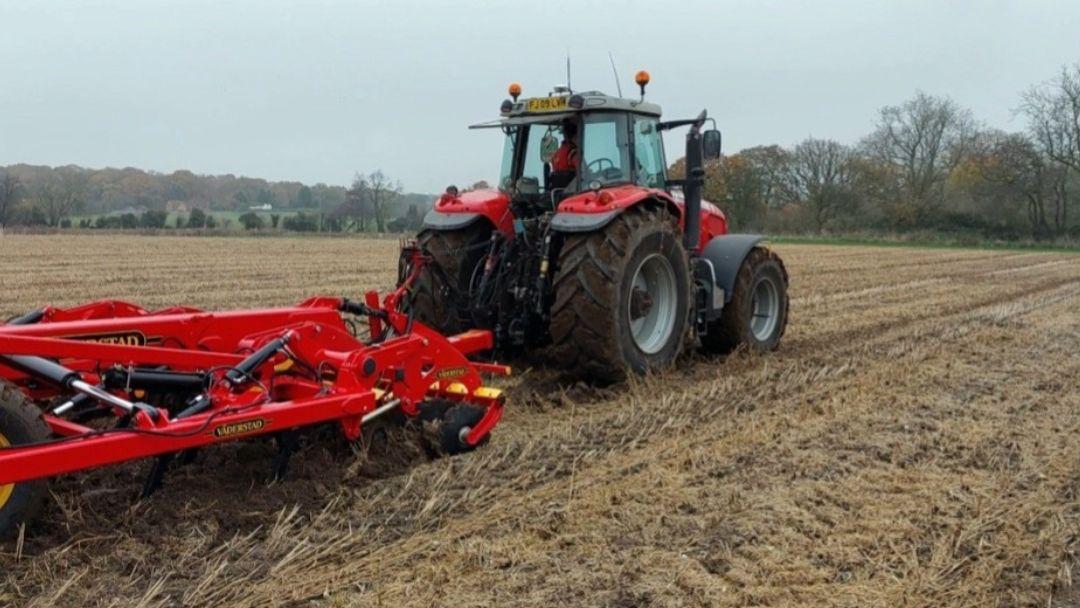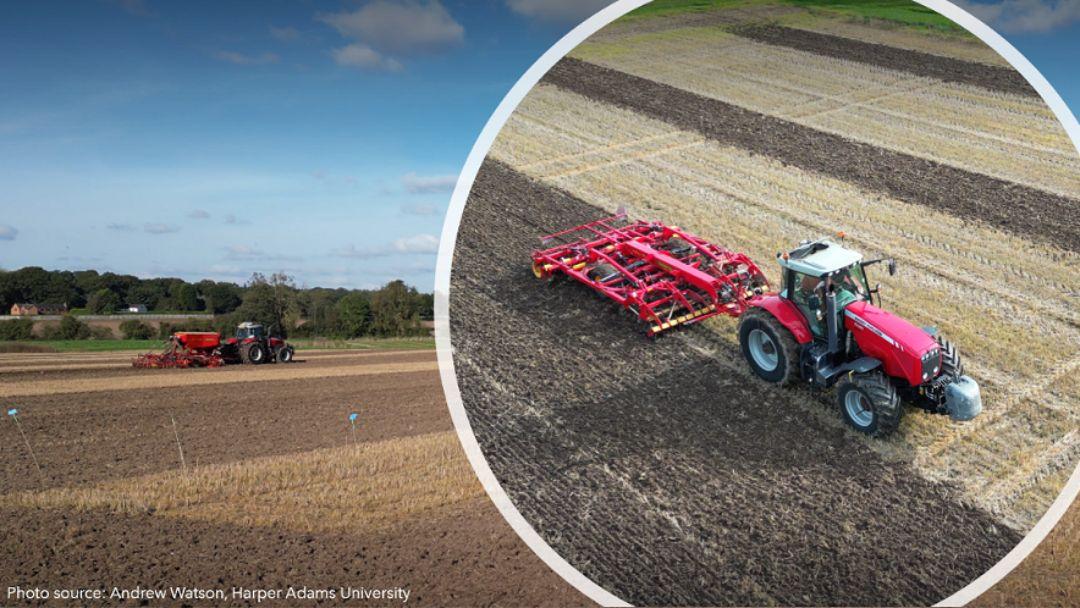Authors: Ana Prada Barrio and Dr Paula Misiewicz
The Traffic and Tillage project is a unique long-term field experiment at Harper Adams University (HA), United Kingdom (UK). It started in 2011 and studies the effects of interactions between different traffic management and tillage practices. The project is led by Dr Paula Misiewicz, a Senior Lecturer in soil and water management at HA, and is funded by The Morley Agricultural Foundation and Douglas Bomford Trust with in-kind support from Vaderstad, Michelin, AGCO and Harper Adams University.
The traffic and tillage experimental site covers an area of nearly 3 hectares with 36 plots (80 m x 4 m) in 4 complete randomised blocks.

Figure 1 – a) Experimental design map showing the distribution of the blocks and plots and the different traffic and tillage treatments. b) Aerial photo of the experimental site.
The project investigates soil properties and crop performance and has allowed three graduates to complete their PhDs (Emily Smith, Anthony Millington and Magdalena Kaczorowska-Dolowy) whose research focused on soil physical conditions, yield and cost/benefits and soil biological and health conditions. Currently, Ana Prada Barrio (PhD student) is studying the impacts of the different management practices on soil organic carbon (SOC) dynamics and soil carbon stocks. The traffic conditions being investigated are:
- STP: standard inflation pressure tyres (front 120 kPa, rear 150 kPa)
- LTP: low inflation pressure (high flexion) tyres (front and rear 70 kPa)
- CTF: controlled traffic farming (front and rear 70 kPa)
Three tillage treatments are used:
- deep (25 cm)
- shallow (10 cm)
- no-tillage
The work is being done with a range of cereal crops grown in arable farming in the UK. The results of the continuing long-term study have shown that the effect of both traffic management and tillage systems can have significant effects on crop yield and farm economy together with soil biology and health. In general, we have seen improvements in all aspects as a result of reduced trafficking and tillage.
Soil organic carbon is a component of soil organic matter (SOM). Many cropland soils in the UK have reduced SOM due to years of intense ploughing, extensive use of monocultures and the removal of crop biomass. It is argued that they have the potential to store more carbon through building SOM.
Initial findings showed that CTF with no-tillage increased the carbon content of both SOM (%) (0-10 cm) and SOC stocks (0-30 cm), suggesting that the lack of soil disturbance enhances SOM retention by increasing the protection of carbon in soil aggregates.
CTF with no-tillage stored on average (by equivalent soil mass (ESM) at 0-30 cm depth) 10 t/ha more than the other treatments. The highest SOC stocks were recorded on CTF no-tillage followed by LTP shallow tillage.
At 0-10 cm depth, the highest concentration of SOM (%) was observed in CTF no-tillage (4.9%) while the lowest concentrations were in deep tillage treatments (4.4%). On average, CTF treatments had higher SOM (%) than LTP and STP treatments. Both no-tillage and shallow tillage had higher SOM (%) than deep tillage treatments. These results confirm that soils have different levels of potential to store carbon dependent on management, with almost 10 t/ha more C stored under the best management practice.
This leads to the question of why and how more C is stored under some treatments than others. To explore this, Ana Prada Barrio grew millet, a C4 plant, in soils where only C3 plants have grown previously. Measuring the natural abundance of 12C/ 13C stable isotopes will allow us to trace the flow of carbon from the C4 plants into the different SOM fractions and soil depths. This will provide insights into the mechanisms that determine the residence time of C in soils and how they are affected by traffic and tillage treatments over time.
Results derived from these experiments will inform the development of management practices for increasing soil C storage to improve soil health, and therefore soil resilience and climate change adaptation. Knowledge of soil C dynamics, combined with crop information, will enable the impact of tillage and traffic systems to be quantified to assist farmers with making evidence-based decisions regarding soil and mechanisation management options.

Figure 2 – Tillage operations performed by a Massey Ferguson 8480 coupled with a 4m Väderstad TopDown cultivator (that can be adjusted for shallow and deep tillage) removing the cultivating element for no-tillage plots to avoid additional soil disturbance.

Figure 3a – Drilling operations performed by a Massey Ferguson 8480 with an extra load of 1400 kg in the front, coupled with a 4 m Väderstad Spirit pneumatic seed drill.

Figure 3b –4 m Väderstad Spirit pneumatic seed drill used for plot sowing.
